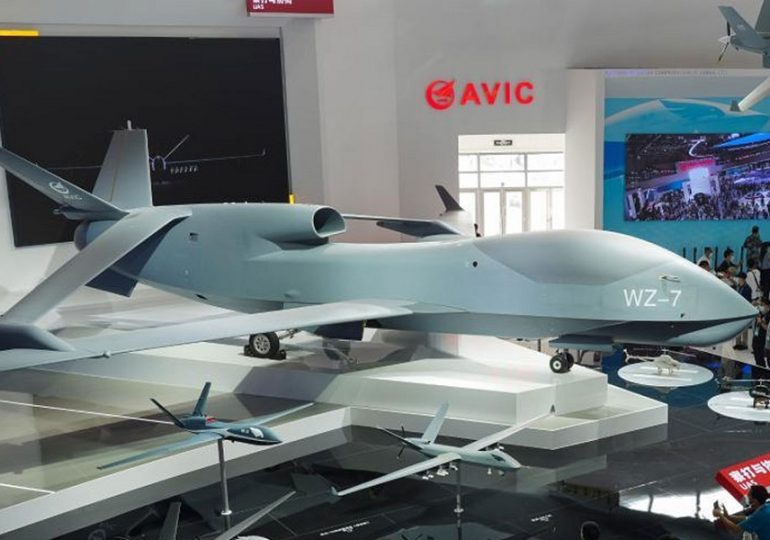CHINA seems to be on its way to replacing human soldiers completely in modern warfare scenarios.
The country has revealed shocking plans for advanced robot soldiers and high-tech drones to be sent to complex overseas missions within the next 10 years.
The People’s Republic of China/XinhuaChina already had a fleet of spy drones that can mark ‘kill targets’[/caption]
China has previously built gun-wielding robot dogs that can be dropped in a warzone from a drone
AlamyAn artist impression of what a Chinese drone swarm could look like[/caption]
The Chinese People’s Liberation Army (PLA) – the armed wing of Xi Jinping‘s Chinese Communist Party – has been working closely with scientists to develop new-age drones that can replace humans completely in complex military missions.
The drones would have the ability to fly long distances, go deep inside water and remain unseen for longer before emerging swiftly again when need be, the SCMP reports.
At command, these drones would race towards the target, deliver a fatal blow, and return back underwater before disappearing in the waves again. by the enemy.
A recent paper published by the PLA details a hypothetical overseas special operations plan where such advanced warfare techniques could be leveraged.
According to the scenario, in 2035, a minor conflict breaks out between China and one of its neighbouring countries.
Both sides agree to use only small arms, such as small boats, drones, and anti-aircraft guns, to keep the expenses low and prevent wider escalations.
There is a long river with great depths flowing between China and its enemy – and the Chinese army has been assigned a special operation to launch a swift, silent attack across the rivers.
The target is a critical military installation that lies hidden along the river.
For this operation, the PLA argues that purpose-built drones would be the most efficient choice for the Chinese Army to go on such missions.
They must be designed for special operations, operate alone or in swarms, navigate river depths, evade detection, and launch torpedoes at enemy boats.
To remain unseen, they must stay close to the riverbed, staying submerged for long periods and navigating obstacles such as reefs with ease.
The PLA also suggests they require the drones to have advanced intelligence, surveillance, and reconnaissance (ISR) systems to hover over the battlefield, assess damage, and determine if further action is necessary after the initial attack.
If the enemy forces attempt to flee, the drones must also be capable of pursuing and eliminating them, ensuring complete victory before returning to Chinese territory.
The Chinese military has now entered the drone warfare arms race – and aims to overwhelm competitors with vast numerical superiority.
According to PLA, the special drone project has already landed, and more such advanced equipments are being developed.
China has a plethora of advanced drone systems that can wreak havoc in a warzone without having to send human soldiers.
One such is the gun-wielding robot dog that can be deployed anywhere in urban warfare scenarios.
The battle-ready bionic dog is believed to behave a Chinese QBB-97 light machine gun mounted to its back, according to WarZone.
And the terrifying weapon can reportedly fire up to 650 rounds a minute.
Another such warfare drone is China’s “Robo-Shark” powered by a bionic tailfin to spy on enemy ships and hunt US Navy submarines.
The underwater robot looks like a small shark and its fin has been specially built to replace the traditional propeller.
It comes as China has been ramping up its military capabilities which could pose a serious threat to the world.
Just a few months ago, a Pentagon report claimed the country is planning to double up its nuclear arsenal in just six years – and have enough nukes to destroy the world 10 times over.
The nation may also be exploring the development of non-nuclear intercontinental ballistic missiles (ICBM), according to the report.
Former CIA China expert, Dennis Wilder, expressed concern about the warning on conventional ICBMs as they could destabilise the military balance and complicate the situation for military planners.
“China could, in a US-China crisis, for the first time threaten strikes against major US population centres without having to cross the nuclear threshold, which risks a massive US nuclear barrage in response,” Wilder told the Financial Times.
Conventional ICBMs can also cause another problem, in which they “would likely be indistinguishable from their nuclear ICBMs”.
China’s drone fleet
CHINA has a long history of developing and exporting advanced drones for on-field combat
These are the top AI drones China has that use machine learning and sensors to gather data, assess their environment, and even fire an attack on their own.
Harbin Giant Eagle – Also known as the Harbin BZK-005, the “Giant Eagle” is one of China’s active UAVs.
It’s a high-altitude, long-range UAV mainly used for reconnaissance.
The drone was designed by Beijing University of Aeronautics & Astronautics and Harbin Aircraft Industry (Group) Co., Ltd.
China reportedly uses this UAV model in both its navy and air force.
Giant Eagle has several features integrated into its design, such as a satellite data link antenna.
Chengdu Cloud Shadow – The Chengdu Cloud Shadow, also dubbed Chengdu WZ-10, is a High-Altitude Long Endurance (HALE) type of UAV.
It comes in two different models: one for reconnaissance and one for combat precision strike missions.
The combat version features a range of weaponry to attack ground-based targets.
Meanwhile, the intelligence model is packed with equipment that enables battlefield assessment, observation, and monitoring.
Guizhou Soaring Dragon – The Guizhou WZ-7 Soaring Dragon is also a HALE drone, like Cloud Shadow.
Designed by the Chengdu Aircraft Industry Group, this UAV was primarily developed for aerial reconnaissance.
However, it can also provide targeting data for anti-ship ballistic and cruise missiles.
GettyThe drones are set to replace human soldiers by 2035[/caption]
AFPXi Jinping has been ramping up China’s military capabilities in recent[/caption]
Leave a comment








